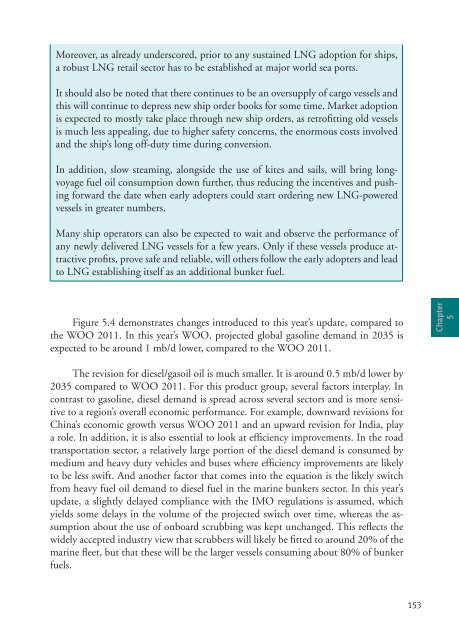World Oil Outlook - Opec
World Oil Outlook - Opec
World Oil Outlook - Opec
- TAGS
- world
- outlook
- opec
- www.opec.org
Create successful ePaper yourself
Turn your PDF publications into a flip-book with our unique Google optimized e-Paper software.
Moreover, as already underscored, prior to any sustained LNG adoption for ships,<br />
a robust LNG retail sector has to be established at major world sea ports.<br />
It should also be noted that there continues to be an oversupply of cargo vessels and<br />
this will continue to depress new ship order books for some time. Market adoption<br />
is expected to mostly take place through new ship orders, as retrofitting old vessels<br />
is much less appealing, due to higher safety concerns, the enormous costs involved<br />
and the ship’s long off-duty time during conversion.<br />
In addition, slow steaming, alongside the use of kites and sails, will bring longvoyage<br />
fuel oil consumption down further, thus reducing the incentives and pushing<br />
forward the date when early adopters could start ordering new LNG-powered<br />
vessels in greater numbers.<br />
Many ship operators can also be expected to wait and observe the performance of<br />
any newly delivered LNG vessels for a few years. Only if these vessels produce attractive<br />
profits, prove safe and reliable, will others follow the early adopters and lead<br />
to LNG establishing itself as an additional bunker fuel.<br />
Figure 5.4 demonstrates changes introduced to this year’s update, compared to<br />
the WOO 2011. In this year’s WOO, projected global gasoline demand in 2035 is<br />
expected to be around 1 mb/d lower, compared to the WOO 2011.<br />
The revision for diesel/gasoil oil is much smaller. It is around 0.5 mb/d lower by<br />
2035 compared to WOO 2011. For this product group, several factors interplay. In<br />
contrast to gasoline, diesel demand is spread across several sectors and is more sensitive<br />
to a region’s overall economic performance. For example, downward revisions for<br />
China’s economic growth versus WOO 2011 and an upward revision for India, play<br />
a role. In addition, it is also essential to look at efficiency improvements. In the road<br />
transportation sector, a relatively large portion of the diesel demand is consumed by<br />
medium and heavy duty vehicles and buses where efficiency improvements are likely<br />
to be less swift. And another factor that comes into the equation is the likely switch<br />
from heavy fuel oil demand to diesel fuel in the marine bunkers sector. In this year’s<br />
update, a slightly delayed compliance with the IMO regulations is assumed, which<br />
yields some delays in the volume of the projected switch over time, whereas the assumption<br />
about the use of onboard scrubbing was kept unchanged. This reflects the<br />
widely accepted industry view that scrubbers will likely be fitted to around 20% of the<br />
marine fleet, but that these will be the larger vessels consuming about 80% of bunker<br />
fuels.<br />
153<br />
Chapter<br />
5
















